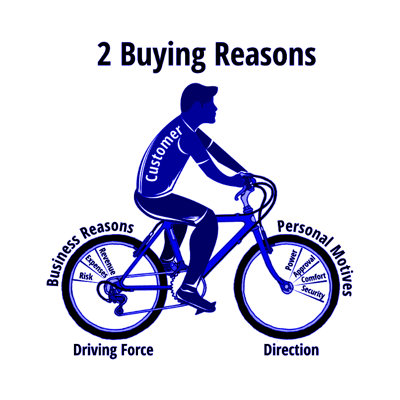There are two forces that drive a customer’s buying decision: business reasons and personal motives. A successful sale depends on your ability to accurately identify the reason your customer has for buying and what he’s looking for in a vendor. If you fall short in either area, you are likely to lose the sale.
To understand these forces and how they relate to each other, it helps to imagine a business as a bicycle[1]. On a bicycle, the rear wheel is where the force that propels the bike forward is applied. The front wheel is the one that controls the bike’s direction.
 In sales, your customer is a bike rider, and the wheels of his bike represent the reasons and motives behind his buying decision. The rear wheel is the business reasons that drive your customer to buy, i.e. his needs or desired outcome. The front wheel is the factor that determines the direction in which he will go - whether he buys from you or from someone else – and is usually determined by personal motives.
In sales, your customer is a bike rider, and the wheels of his bike represent the reasons and motives behind his buying decision. The rear wheel is the business reasons that drive your customer to buy, i.e. his needs or desired outcome. The front wheel is the factor that determines the direction in which he will go - whether he buys from you or from someone else – and is usually determined by personal motives.
For sales success, it is critical to realize that the two cannot be separated. The sales rep who best understands and addresses both the business reasons and personal motives will be the one who wins.
The sales rep who fails to understand either wheel will find his customer steering in another direction.
In this two-part series, we’ll look at each wheel and the spokes that support them.
Part 1 - The rear wheel: understanding the business reasons
There are three business drivers behind most buying decisions: revenue, expenses, and risk. The goal of all businesses is to increase profits, survive, and grow. Profits are affected by three things, and thus customers buy your product or services for three primary and interrelated reasons.
Reason 1: to increase or protect revenue. Business leaders seek to increase revenue by hiring a marketing firm to improve their brand or image in the market place. They may purchase a product or service to improve sales productivity such as a CRM, a leads database, or sales training. They hire more sales reps or expand into new territories to increase revenue. New products or offerings are launched into the market place to increase revenue.
Leaders often protect revenue by buying their competition. Microsoft is one company who has done this several times to eliminate a superior software product; Microsoft buys the company and then either shelves the technology or integrates it into their own offerings. Companies will sell at a loss or even open non-productive territories to keep the competition from establishing a foothold. Non-compete contracts are required by employees to protect revenue.
Reason 2: to reduce or control expenses. Reducing expenses goes directly to the bottom line, increases profits, and may also allow funds to be redirected toward generating revenue. Companies may reduce expenses by changing health insurance plans, consolidating suppliers, or hiring consultants to improve productivity with fixed resources. Companies will also focus on keeping expenses flat, i.e. controlling expenses, by seeking greater efficiencies in operations and leveraging existing resources to a greater extent. Controlling expenses can enable a company to grow without increasing overhead.
I had a client whose sales were down, making the operational overhead expenses as a percentage of sales higher than he wanted, so he laid off several operations people to reduce their total overhead. When the Affordable Care Act hit, I know of several companies that totally restructured their healthcare plans, switching to new insurance companies with the goal of keeping health insurance expenses flat or controlling the growth of that expense.
Reason 3: to mitigate risk. Managing or offsetting risk is critical for business continuity. Companies take great care in putting measures in place to ensure they can continue to operate after a disaster or crisis disrupts business. Ensuring the protection of company data, intellectual or physical property, safety, the wellbeing of employees, and other key issues are all about mitigating risk, which is closely tied to reasons 1 and 2.
Offsite back up for data, or moving the data to the “cloud” is a common practice for reducing risk. Implementing wellness plans for employees encourages better health, which reduces the sick days and downtime. Safety programs reduce employee injuries, which affect productivity and increase expenses. Errors and Omissions, liability, fire and key man life insurance protects business continuity. Fences and locks on doors protect physical property from damage. All these are methods used to reduce risk, thereby protecting revenue and avoiding the expenses associated with these types of loss.
How to address your customer’s business reasons for buying
Since increasing or protecting revenue, reducing or controlling expenses, and reducing risk are the foundation of all buying decisions, your conversations should always be targeted to impacting these three areas. Buyers are communicating with you because they desire to achieve an outcome; therefore, all sales calls should be made with the goal of understanding the desired outcome and how it impacts your customer’s business drivers.
Here is a simple exercise you or your sales team can do to make sure you address these concerns. For each of your products/services, answer the three questions below and prepare examples or illustrative stories around each.
- How do my products/services help increase or protect revenue?
- How do my products/services reduce or control expenses?
- How do my products/services reduce risk to:
- People
- Data
- Business Continuity
- Finances
If you are a sales manager, a great way to do this with your team is to assign a product or service to each of your sales reps and have them complete the exercise. Then have a meeting where each person presents his/her responses and have group discussion to share ideas on how to refine and improve the talking points for that particular product/service.
Too many sales reps present features and benefits without ever understanding if or how their product or service impacts the customer in these areas. Those who identify needs, problems, and/or goals and work on tying their products and services to the buyer’s desired outcome are in much better position to earn the sale. And they typically do.
[1] Concept taken from a webinar by Wilson Learning.

